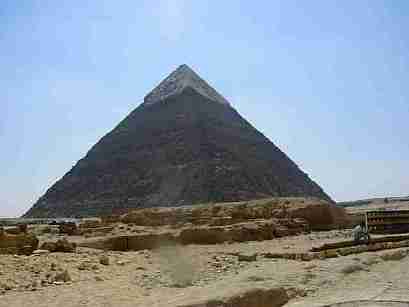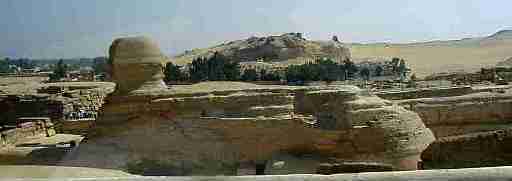A tourist viewing the Giza pyramids for the first time is like the yokel who, walking down Fifth Avenue in New York, stares up and exclaims, "Look at the tall buildings!" The pyramids are tall and they are big and they are old and they are mysterious. And because they are all of these and because there's no point in duplicating what's on the web in abundance, I suggest Guardian's Egypt and the Egyptian Ministry of Tourism's comprehensive historical site as beginning points for ancient Egypt in general and pryamids in particular. What follows is dependent on what I was able to photograph, with some attempt to put it into context.
The three great pyramids were built by kings of Dynasty IV (Old Kingdom -- 2650-2465 BCE) whose capital remained at Memphis, but who made their principal necropolis on the Giza plateau rather than at Saqqara. Little is known about these kings (Khufu [Greek: Cheops], great pyramid; Khafre [Greek: Chefren], pyramid that retains some casing stones at its top; and Menkaura [Greek: Mycerinus], smallest pyramid) other than that they built pyramids and maintained strong centralized governments.
The sole surviving of the "Seven Wonders of the Ancient World," the pyramids have been the occasion of speculation about their construction, origin, and purpose for thousands of years. Much of the conjecture is being resolved by improved technology and scientific excavation.
| For instance, the discovery of graffiti made by workmen building the Great Pyramid makes certain that it was not built by ancient astronauts but was indeed constructed during the reign of Khufu (Zahi Hawass, "The Discovery of the Osiris Tomb at Giza," Horus,July/September 2000). Seen here is the original entrance to the Great Pyramid that was hidden by casing stones and the present entrance (where the people are) that was literally blasted out (or into!) by Caliph Abdullah al Mamum in the 9th century CE. To his great disappointment, he found the pyramid empty of treasure but filled with passageways, thus defining the mystery of the pyramid ever since. Though I was able to climb into the pyramid and reach the King's Chamber, I was discouraged from taking a camera and do not have photographs. But that is not important: There are much better pictures (in motion no less) than I could possibly have taken. The PBS Nova series on the pryamids is well worth some browsing time. |
| On the south side of the wall that encloses the Great Pyramid are two pits that contained disassembled boats. The one seen here has been painstakingly reconstructed and housed in a climate-controlled museum. Other boat pits have also been found, including one that contains another disassembled boat. The pits themselves were boat shaped even to the high prow. What was the purpose of these pits filled with pieces of boats? Zahi Hawass, Undersecretary of State for the Giza Monuments, believes they are "solar boats. The soul of Khufu, as the sun-god Re, travels from the south shaft to take one boat for the day trip and the other boat for the night journey." (Horus, July/September 2000). The incredible amount of time, effort, and wealth that went into the construction of the Great Pyramid complex (including the solar boats, the valley temple, etc.) testifies to the power and authority of a belief system that must have been as "taken for granted" by the ancient Egyptains as today we take for granted that the earth revolves around the sun. |
 | |
The three large pyramids on the Giza plateau, recognizable by people world-wide, are but three of the 108 Egypian pyramids so far discovered. Alongside the Great Pyramids are small pyramids, often made of brick instead of stone, that were tombs for queens or children of the king. The ruins of one such is visible beside Menkaure's pyramid in the phtograph at the top of this page.
Each of the three pyramid complexes consists of a mortuary temple adjacent to the pyramid itself and a "valley" temple near the Nile. The two are connected by a causeway. Beside the ruins of the valley temple of Khafre stands what may well be the most famous statue in the world, the Great Sphinx, complete with its own temple, which has been partially reconstructed.

The Great Sphinx, an integral part of the Khafre funerary complex, is thought to have been constructed during Khafre's reign. Its face is Khafre's face, or so most Egyptologists believe. For most of its 4500-year existence the Sphinx was buried up to its head in sand but was periodically uncovered and repaired. Sahi Zawass has an interesting article on "The History of the Conservation of the Sphinx". Much more is available about the Sphinx at the Egyptian Tourist Agency.